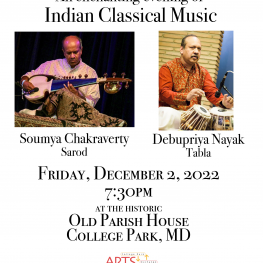Start
December 2, 2022 - 7:30 pm
End
December 2, 2022 - 9:30 pm
Address
Old Parish House, Knox Rd, College Park View mapWhat is Indian classical music?
Indian classical music is the classical music of the Indian subcontinent. Its origins date back to sacred Vedic scriptures over 6,000 years ago where chants developed a system of musical notes and rhythmic cycles. It has two major traditions: the North Indian classical music known as Hindusthani and and the South Indian expression known as Carnatic. These traditions were not distinct until about the 15th century. During the period of Mughal rule of the Indian subcontinent, the traditions separated and evolved into distinct forms. Hindustani music emphasizes improvisation and exploration of all aspects of a Raga, while Carnatic performances tend to be short composition-based. However, the two systems continue to have more common features than differences. Indian classical music has two foundational elements, Raga and Tala. The raga, based on a varied repertoire of Swara (notes including microtones), forms the fabric of a deeply intricate melodic structure, while the tala measures the time cycle. The raga gives an artist a palette to build the melody from sounds, while the tala provides them with a creative framework for rhythmic improvisation using time.
Sarod: The sarod is a stringed instrument used mainly in Hindusthani classical music on the Indian Subcontinent. Along with the Sitar, it is among the most popular and prominent instruments. It is known for a deep, weighty, introspective sound, in contrast with the sweet, overtone-rich texture of the sitar, with sympathetic strings that give it a resonant, reverberant quality. A fretless instrument, it can produce the continuous slides between notes known as meend (glissandi), which are important in Indian music.
Tabla: A Tabla is a pair of twin hand drums from the Indian subcontinent. Since the 18th century, tabla has been the principal percussion instrument in the Hindusthani classical music, where it may be played solo, as accompaniment with other instruments and vocals, and as a part of larger ensembles. Tabla is also frequently played in popular and folk music performances in India, Bangladesh, Pakistan, Nepal, Sri Lanka. The tabla is also an important instrument in the spiritual songs like Kirtans and Sufi music. It is one of the main instruments in Qwaali (sufi) music. Tabla is also played in the Indian classical dance forms called Kathak

